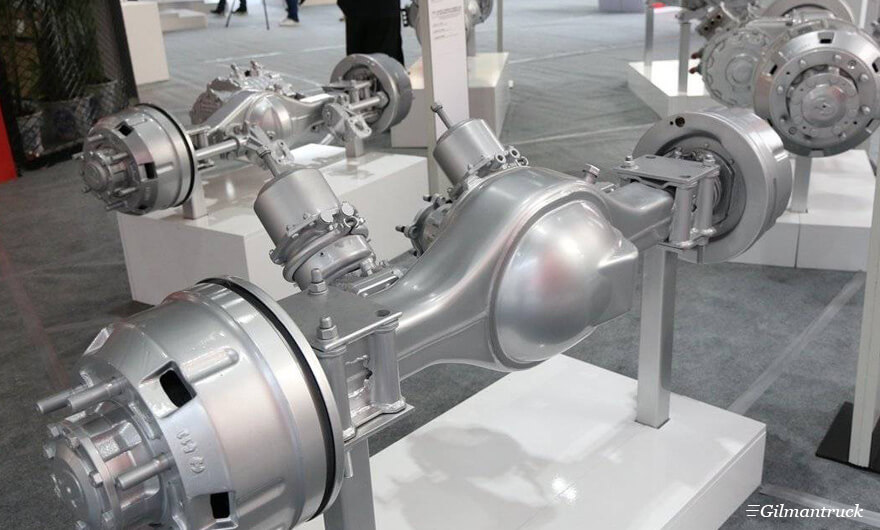How to choose between a semi-floating axle and a hub reduction axle?

As an important component of the transmission system, the characteristics of the axle directly affect the vehicle's driving ability, fuel consumption, and other performance aspects. Axles are mainly divided into single reduction axles and double reduction axles. So, what are the differences between these two types of axles? What working conditions are they suitable for?
The common driving axle mainly consists of components such as the main reducer, differential, half shafts, and axle housing, and its main functions are as follows:
- 1. Transmitting the torque from the engine provided by the universal transmission device to the wheels through the main reducer, differential, half shafts, and hubs, achieving the function of reducing speed and increasing torque.
- 2. Changing the direction of torque transmission through the bevel gear pair in the main reducer.
- 3. Achieving differential speed between the two wheels through the differential to ensure that the inner and outer wheels turn at different speeds.
- 4. Bearing and transmitting forces through the axle housing and wheels.
Simply put, the power generated by the engine is transmitted through the gearbox to the main reducer inside the axle. The main reducer reduces speed and increases torque, driving the differential and half shafts on both sides to transfer power to the wheels, ultimately propelling the vehicle forward. Now, what are the differences between a single-stage reduction axle and a two-stage reduction axle?
Single-stage reduction axles, also known as semi-floating axles, are lightweight and commonly used in highway standard-load transportation. They are primarily employed in cargo trucks, standard-load tractors, and some lightweight dump trucks. These axles are typically found in vehicles designed for relatively smooth road conditions and standardized load transportation. Common models of single-stage reduction axles include 435, 440, 457, 459, 460, 469, and others.
In a single-stage reduction axle, there is only one pair of reduction gears inside the axle housing to achieve speed reduction and torque increase. The structure is relatively simple, and the overall weight is lighter, leading to better heat dissipation and transmission efficiency. This set of reduction gears, similar to the gear ratio commonly indicated on the rear axle housing, represents the transmission ratio of these gears. In vehicles with the same engine and gearbox combination, a higher gear ratio results in slower speed, while a lower gear ratio leads to faster speed.
However, its torque amplification effect may not be particularly prominent. Additionally, due to the relatively large diameter of the gears in the main reducer, the axle housing volume is also large, leading to a smaller ground clearance and potentially impacting the vehicle's off-road capabilities to some extent.
Therefore, single-stage reduction axles are more suitable for operation in favorable conditions, such as standard-load highway transportation and high-speed mainline transportation scenarios. Single-stage reduction axles are very suitable for such applications. However, if you frequently carry heavy loads and often drive on harsh unpaved road surfaces, with a certain requirement for off-road capability, then a two-stage reduction axle would be more suitable for you.
The wheel-end axle provides stronger driving force, making it an effective tool for low-speed heavy-duty applications.
The two-stage reduction axle, also known as the wheel-end reduction axle, is designed with larger main gear ratios and greater ground clearance requirements. Typically, in the two-stage main reducer, the second stage reduction gear mechanism is duplicated into two sets and installed near each of the driving wheels, forming the wheel-end reduction gears. The first stage remains the main reducer. Visually, the wheel-end axle presents a square shape on the central axle housing, and the wheels' ends may appear larger.
Compared to single-stage reduction axles, the wheel-end reduction axle features an additional set of reducers on both sides of the wheels, resembling a planetary gear and sun gear structure. With torque amplified through two stages, the driving force becomes significantly robust, effectively reducing the likelihood of getting stuck in harsh conditions. Additionally, thanks to the reduced diameter of the main reducer's crown gear, the axle housing volume is noticeably smaller, ensuring a sufficiently large minimum ground clearance for the vehicle and enhancing its off-road capability.
The commonly seen wheel-end reduction axles on the market include those from manufacturers like Benz, Styer, and MAN, with 13T and 16T being the main categories. These axles are often used in 8x4 or 6x4 heavy-duty dump trucks. They ensure robust low-speed driving capability and high off-road performance in complex conditions such as construction sites, unpaved roads, and muddy terrain. Additionally, they are more durable and resistant to wear and tear.
Of course, due to the more complex structure of wheel-end reducers, they are heavier, have poorer heat dissipation, consume more fuel, and are prone to tire blowouts if the wheel-end temperature becomes too high. Therefore, they are not suitable for prolonged, long-distance driving at high speeds. This type of wheel-end reduction axle is more suitable for heavy-duty dump trucks and other overweight transportation conditions.
About Us
GilmanTruck is a trusted Chinese exporter of used trucks, with over 10 years of experience in truck sales. We provide professional transportation solutions for industries including freight transport, logistics distribution, construction engineering, and mining excavation.
Contact Us
Email: [email protected]
WhatsApp: +86 131 6435 3366